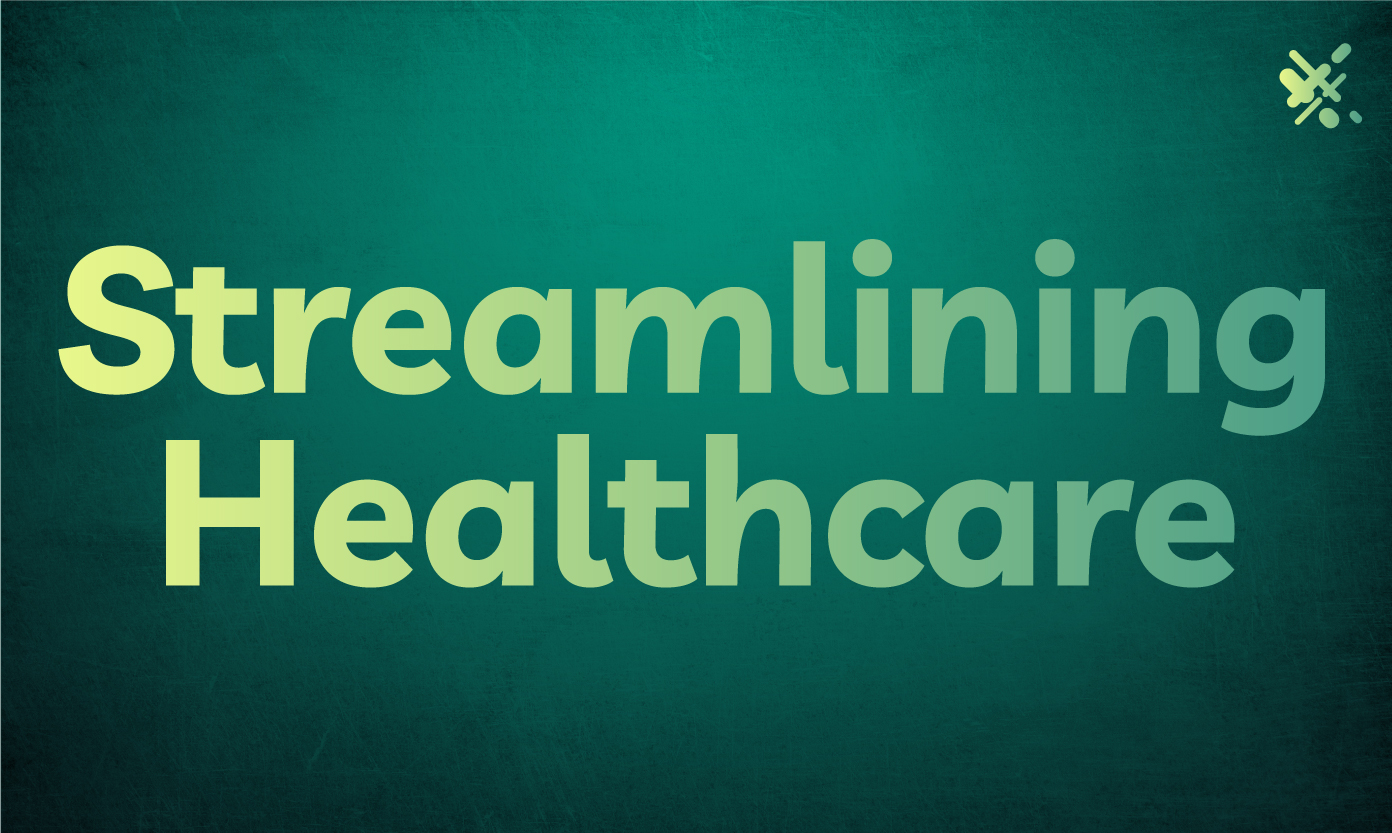Practice management software helps a healthcare practice with business tasks. The number of features such software has will vary based on the provider but may include things like patient scheduling and insurance claims tracking. It may also provide or integrate with debit or credit card management software (e.g., payment processing).
The general idea of practice management software is not unique to the healthcare industry. Numerous industries now use software as a core part of their business and operational infrastructure. Many of these software solutions are cloud-based, meaning the business subscribes to access them remotely.
Sales organizations and service providers use CRM (customer relationship management) to keep track of all their customers. Retail organizations and logistics companies use ERM (enterprise resource management) to keep track of inventory and the supply chain. Many companies use HRM (human resource management) to keep track of employee considerations like payroll and benefits.
Software as a Service…Is It Safe?
These types of software solutions are often referred to as SaaS or software as a service. Even though the software is a digital product, it’s not something the business (in this case, your practice) needs to own. The software company stores all the data in “your system” remotely in their data centers (or perhaps outsources this storage to a company like Amazon, Google, or one of the hundreds of other data storage companies).
Obviously, you will have some questions about the security of this data being stored remotely in some data center halfway across the country. In fact, patient data is more secure this way, in contrast to the old system of paper records.
There are numerous firewalls around the data. The software company has an IT department that routinely tests weaknesses and fills the proverbial gaps in defense. And the data itself is tokenized. This means that as it is stored, it is encrypted into something meaningless—a token representing the underlying data.
And a significant part of defending this data still rests within the walls of your practice. Small businesses (such as medical practice) are targeted 350% more than larger businesses with social engineering attacks like phishing emails.
It’s important to train your staff not to open links in suspicious emails or provide information to suspicious callers. Outside parties may leverage these interactions to gain access to your software systems. Once they are inside, patient data can become compromised. Just as you would not keep the old paper-file charts within easy reach of the waiting room, you must protect access to your practice management software.
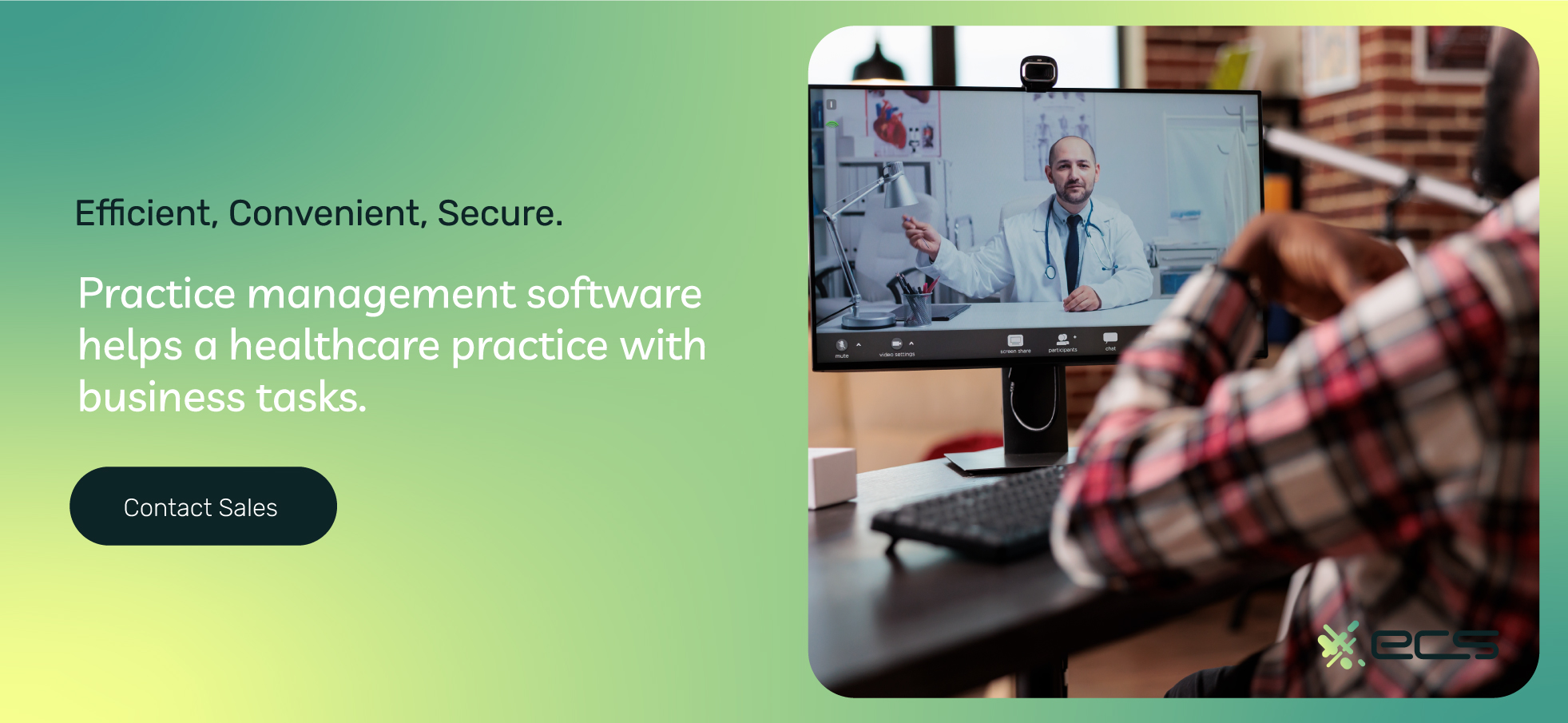
Software and The Medical Profession
In 2020, the domestic healthcare SaaS market was already valued at $12.5 billion and is expected to grow at a 19.5% CAGR through 2028. Digitization and migration of paper systems (or even on-site electronic data storage) to the data cloud was accelerated by the COVID-19 pandemic. The Pandemic was (among other things) a significant industry disruptor in several industries, healthcare included.
Around 49% of organizations in this space are moving towards digitization in some form or another. For 39% of polled organizations, the main goal is facilitating telehealth. For 30%, it is the automation of care management, while for 20%, it is the automation of care pathways. 11% use it to facilitate smoother triage (in hospital settings) and risk assessment.
As we will see, doctors are constantly bombarded with the need to provide care to an ever-expanding market of patients (e.g., shifts to more aged or mature demographics). This may be why 44% of 1,000 surveyed doctors said they were still using paper charts despite incentives from the Federal Government to move to electronic health records (EHRs).
Interestingly, larger institutions have been quicker to adopt software. Just 6% of hospitals are still using paper records. Hospitals have more money, staffing, and resources to smoothly implement switches from legacy systems to new technology. Individual practitioners may find this more daunting, especially as they have so much on their plate.
Care Providers Have a Lot To Juggle
According to The American Medical Association, 36% of practitioners work a reasonable 40-50 hours each week. 14% work fewer than 40 hours, 26% work 51-60 hours, 13% work 61-70 hours, 5% work 71-80 hours, and 5% work more than 80 hours every week. Some doctors are reported to work as many as 100 hours each week, which probably involves a lot of coffee.
Around 40% of doctors see 11-20 patients per day, which is already a lot. 18% see 10 or fewer patients, 27% see 21-30 patients, and (skipping a few stats here) nearly 2% of doctors see 60 patients or more. This last number probably feels stressful to even read. Keep in mind that these types of doctors may be in hospital settings, where they are doing quick consultations.
Only 24% of polled doctors said they have time and energy for more patients. 52% felt they were at full capacity. And nearly 23% said they were overextended and overworked. Doctors are a dedicated lot, and unlike the average American who changes career paths multiple times, they tend to stick with their profession for life.
Most doctors and care providers go into healthcare to provide care. There is an interesting and statistically significant difference between male and female doctors regarding how much time they spend with patients. For instance, 15% of female doctors spend at least 25 minutes with a patient, while only 11% of male doctors report the same. Closer in number are those who spend 13-16 minutes with each patient (27% to 29%, respectively).
Can Receptionists Alone Fill the Need?
The point of all these statistics is to illustrate that doctors are busy. This is why doctors traditionally hire receptionists to contact patients, make an appointment schedule, run medical billing, and other administrative tasks. Like any business owner, doctors outsource these concerns to an employee so that they can focus on the business of providing care.
But receptionists, therefore, also have a lot to juggle. Interestingly, an overwhelming 95% of receptionists are women, while only 5% are men. This may speak to the psychological nature of multi-tasking required of receptionist work, which—to the chagrin of activists who have hijacked the scientific process—has indeed been confirmed by research.
Receptionists Are Also Busy
As mentioned, receptionists must schedule appointments, process payments, and bill insurance. They must field phone calls and emails from patients with “just a quick question” for the doctor. Receptionists handle charts, forward prescriptions to the pharmacy, arrange lab appointments, and they must order pizza. Veggie, please, but hold the shrooms.
With all these things to do, likely, one receptionist cannot do them all, especially for the 27% of doctors we mentioned who are seeing 21-30 patients each day (and certainly for those seeing more). One obvious solution is hiring more receptionists, which is not necessarily cost-effective. And even if more receptionists are hired, as the practice grows, each one will still have a lot to juggle.
The best solution to the problem of efficiency with administrative tasks is a problem that software can solve. Around 52% of polled practitioners are under stress. And receptionists are burned out as well. Front office staff in healthcare settings report significantly lower rates of inspiration (83%) versus backend staff (97%) and management (94%).
They report lower intentions to stay (75%) versus backend staff (81%) versus management (89%). And they report lower intentions to recommend their practice to a friend or family member in search of work (81% to 91% and 93%).
As a side note, these percentages are probably much higher than workforce averages, which tells you that healthcare professionals are generally well compensated and find meaning in their work. However, there is room for improvement in keeping patient records, invoicing payments, and other business-end practices.
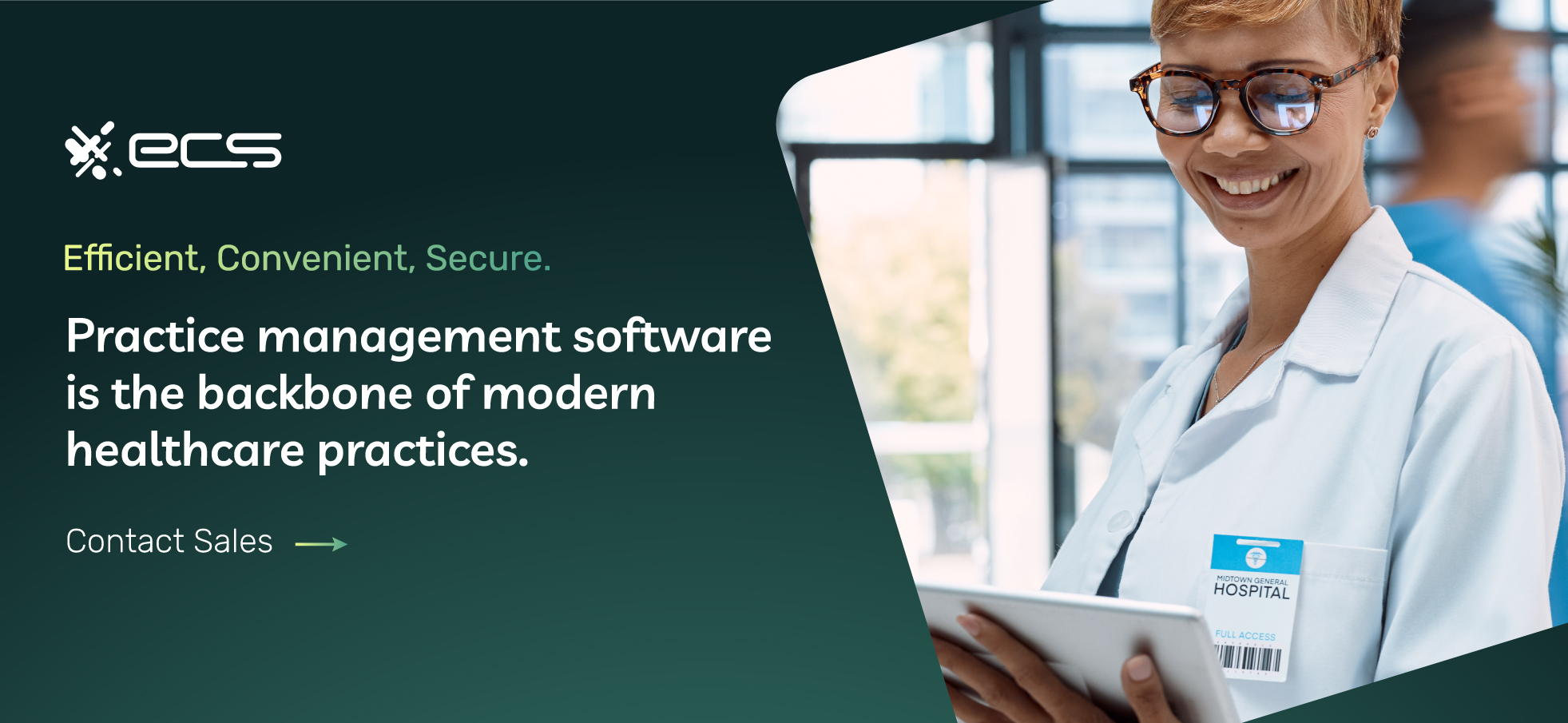
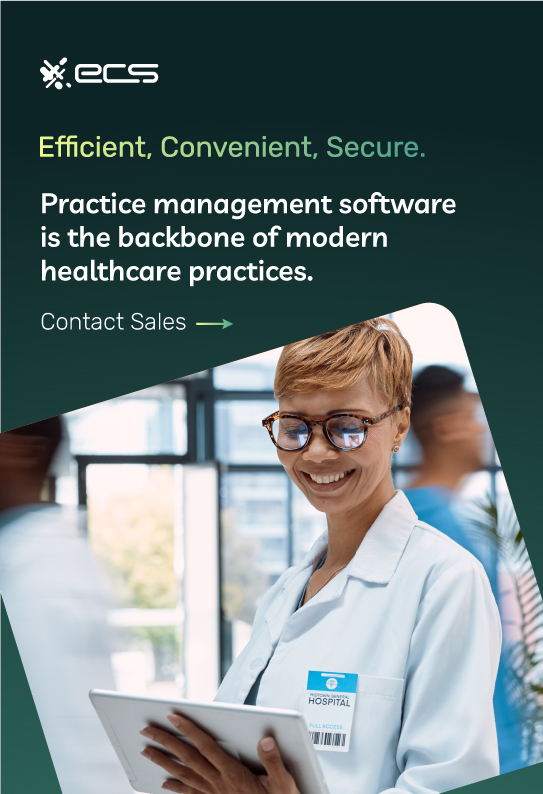
Is Practice Management Software the Same As EHR?
EHR stands for electronic health records. These are the patient “charts” that doctors used to carry around (and some still do). The EHR contains a patient’s medical history: diagnoses, treatments, medications, surgeries, allergies, immunizations, and lab and test results.
As of now, there is no universal EHR. California is creating a prototype universal EHR for its residents. But outside of that, each healthcare system or practice has its own. Organizations that use the same software may be able to transfer data (with patient consent).
Certainly, different locations within the same organization (a system like Kaiser) can transfer chart data. But if a patient moves from one practice to another, they will likely need to ask their old practitioner to “transfer their chart” to the new doctor.
As you can imagine, this might create some gaps in the medical history. It also creates a negative patient experience when patients who visit a specialist are asked to fill out lengthy forms about their entire life story. It seems that the healthcare profession is moving towards more integration between practices, which will be, in large part, facilitated by cloud-based software.
However, we want to focus on practice management software and its integration with credit card processing software. Practice Management Software (which we will continue to avoid abridging for obvious reasons) is not the same as EHR, but it may integrate with EHR. This payment management software combo can be especially helpful for accounts payable, especially because of how medical billing works.
EHR + Practice Management Software: Making Accounting Easier
When it’s time for a practice to collect remission from the insurance company, they will send an 837 EDI to the patient’s insurer. This form will specify which of the 55,000 ailment codes is applicable and what type of patient care was provided. In the meantime, the practice will collect a copay from the patient.
The insurance company will review this form and send back an 835 ERA, which outlines what they are willing to cover (hopefully more and not less). The entire process can take days or weeks to go through. By the time it’s done, several treatments have been lumped together for one payment to the practitioner.
The amount of this payment reflects a number of consultations and treatments. There is no way to parse out what it includes just by looking at the dollar amount of the deposit. This has to be compared against the 835 (sent by the insurer) and the 837 (sent by the practice). This accounting can obviously take hours (sometimes dozens of hours) to unravel and make sure the practice is getting paid for everything they want to.
This process becomes much easier when there is some way to integrate the health records found within EHR with the accounting in the practice management software. Of course, it also becomes easier if your practice has totally outsourced medical billing to a third party. But even if it hasn’t, looking at the books can help you ensure you’re getting paid.
What About HIPAA Laws?
Integrating EHR with accounting software will bring some HIPAA rules into play. The HIPAA Act was passed in 1996 to primarily protect patient privacy. Personal information about patients must be communicated discreetly through secure channels. It also requires the patient’s consent before sending it to a third party, like another practice or an insurer.
HIPAA specifies two types of entities: covered entities and business associates. Covered entities are the primary organizations that collect, curate, create, and send patient data. For example, a practitioner consulting with a patient, making a chart, and sending a diagnosis and treatment plan to the insurer is a covered entity.
Business associates are any parties that may come into contact with sensitive patient information. This includes a surprising number of businesses that provide services to practitioners. Lawyers, accountants, email providers, software companies, paper shredders, and financial institutions are all business associates.
A Business Associate Agreement or BAA is needed between a covered entity and every business associate they work with. Since practice management software involves dealing with patient data (names, addresses, phone numbers, and possibly payment information), you will need a BAA for that software provider.
This is true even if the software does not integrate with actual cloud-based “patient charts,” as discussed above. That’s because HIPAA laws about privacy also involve personal and financial information.
ECS Payments and Practice Management Bridge
The Practice Management Bridge platform has been serving healthcare professionals for over three decades. They are facilitating 170,000 healthcare transactions every day and $19 million in mobile payments every month. They have 161,000 subscribers and are keeping patients in the loop with 9 million text messages per month, which is almost as many as the average teenager is sending (actually, the average teen sends about 1,825 texts per month).
Let’s look at some of the products and services offered by the Practice Management Bridge platform. Keep in mind that these are just a few of the services they offer.
Card on File (COF)
Card on file means storing patient payment information, both for automated payments and for a-al-carte visits and products. The COF payment option is a great way to streamline the patient experience.
Patients will not have to settle copays after or before their visit. Rather, they can be informed that the card on file will be run to make payment. This will not only streamline the patient experience but keep your cash flow on track.
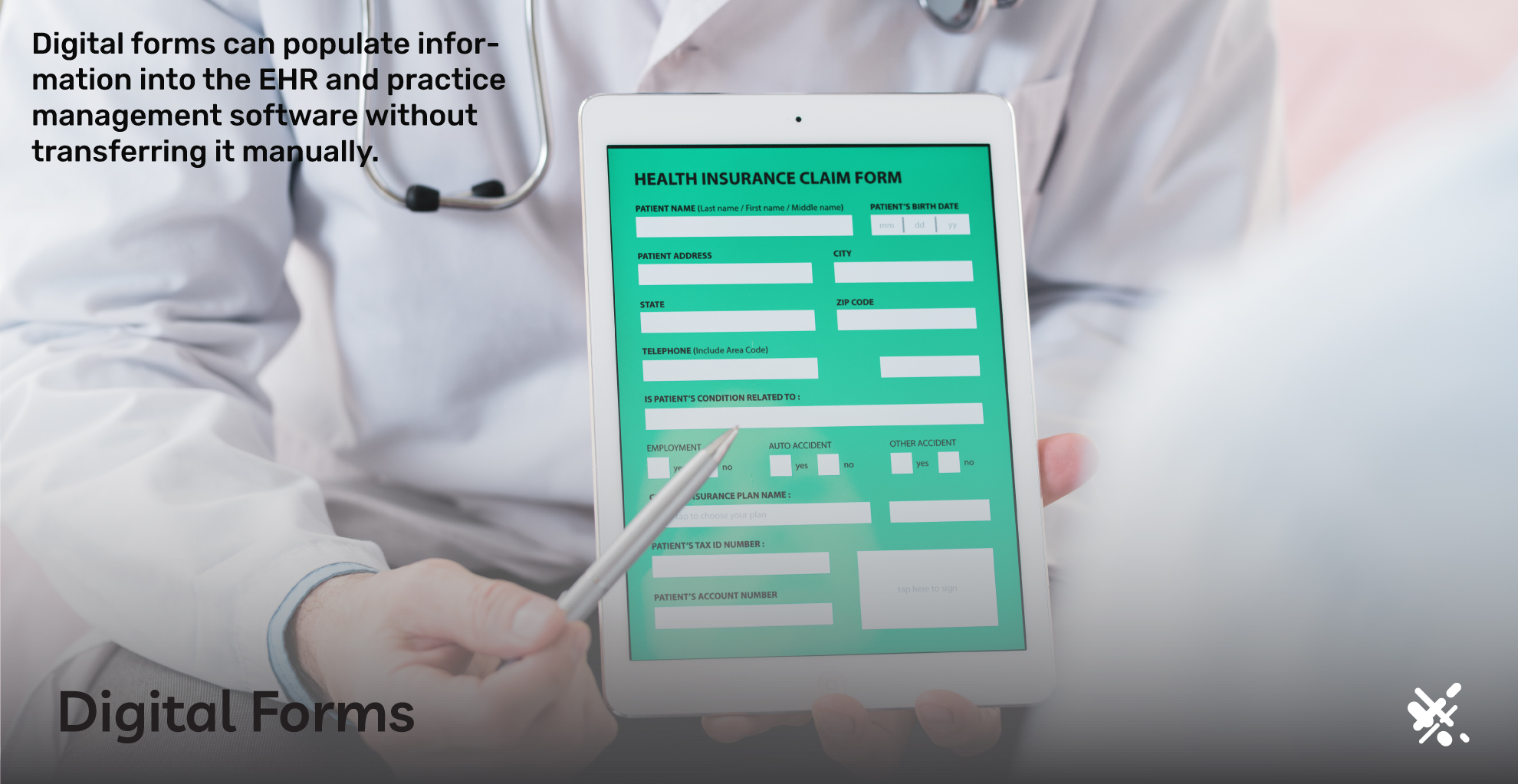
Digital Forms
As mentioned, many practitioners give patients paper forms to fill out while they wait. This can certainly keep patients busy, although so can Soduku, word searches, and free wifi. Patients may find these paper forms cumbersome, and their handwriting may be illegible (we won’t go into doctors’ handwriting here).
Digital forms can be provided instead and filled out by the patient on their own mobile device or provided tablets. These digital forms can populate information into the EHR and practice management software without transferring it manually.
Patient Scheduling
This is one of the most mentally draining tasks of front-end work (or, if not draining, at least mentally strenuous). Receptionists must juggle the patient’s schedule against those of other patients and the doctor. Some visits require more time than others, which further complicates the picture.
We do not know how receptionists used to do all this with a paper calendar book. But in any case, most organizations use practice management software to book patient appointments.
The Practice Management Bridge platform can also facilitate online appointment settings so patients can book an appointment themselves. The software can also detect cancellations and prompt receptionists to contact other patients to fill vacant spots.
Patient Engagement
The Practice Management Bridge platform can also keep your patients engaged. For instance, you can send text reminders to patients about their upcoming visits (per HIPAA guidelines, you will need to obtain consent for sending this type of information over an unsecured channel).
Missed appointments are no simple matter. They may cost the health industry as much as $150 billion per year. This is probably why 52% of practices use multiple methods for reminding patients about an upcoming appointment, which sort of reminds you of that scene from The Cable Guy (the one with the answering machine).
Nearly 30% of practices remind their patients with a phone call. Around 4% use text messages, and a little over 1% use email. There is some real opportunity here for patient engagement, as text messages have an extremely high read rate. 75% of polled phone users read every text message, 21% only read them from numbers they recognize, and 4% don’t read them at all (which probably includes your teenager past curfew).
Other studies are even more optimistic about the effectiveness of text messages, suggesting that texts have a whopping 98% open rate compared to a 22% rate for email. While this study specifically focused on marketing, it illustrates the effectiveness of text communication.
The Practice Management Bridge platform can facilitate keeping patients in the loop with texted reminders and other forms of patient-approved communication (automated calls and emails). This can help avoid missed appointments, which in turn saves your practice from lots of frustration and lost revenue.
Patient Portals and Communication
The Practice Management Bridge platform can also facilitate ongoing patient communication by integrating with patient portals and text messaging services. Not every practice uses this modality to communicate with patients, but some doctors offer it. Patients use these portals to view test and lab results and email questions to their care provider through a secure, HIPAA-compliant channel.
This type of solution does not allow patients to access the internal EHR but does grant them access to a patient-facing “chart” of their medical history. Most practitioners find that having this type of messaging platform can alleviate the influx of phone calls about non-urgent matters. They can respond to messages between visits or when they have time.
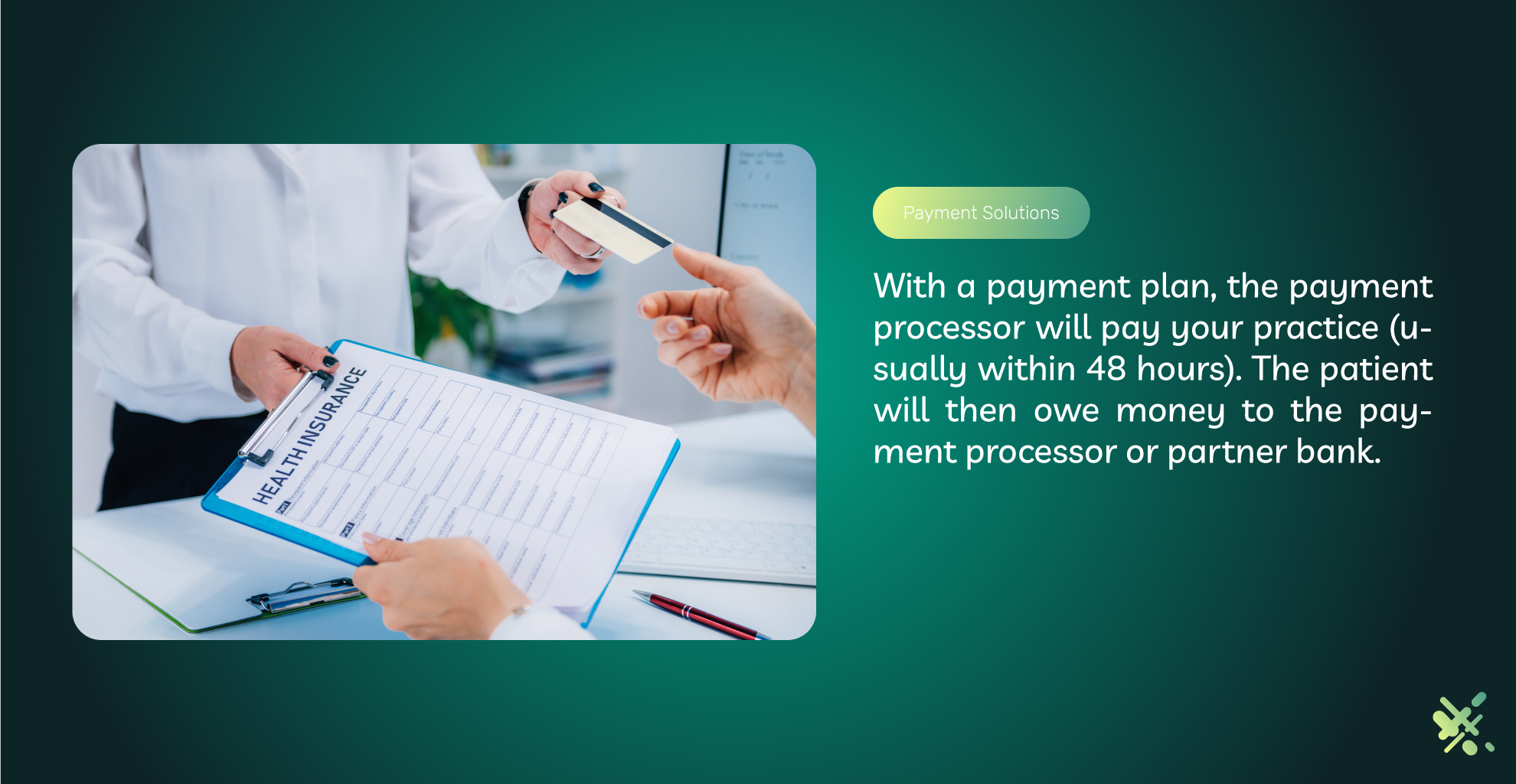
Payment Plans and Patient Financing
Many patients would be willing to forego medical care if it seemed financially beyond their means. For instance, almost 40% of polled patients would even be willing to give up insurance if the premiums and copays became too expensive, and 74% feel stressed about the topic.
23% of Baby Boomers, 37% of Gen Xers, and 22% of millennials actually delayed a treatment or medication due to cost issues. 16% of Boomers, 29% of Gen Xrs, and 19% of millennials skipped an appointment for the same reasons. These numbers are quite dismal and speak to the state of debt and financial stress saturating today’s consumers.
With payment plans, you can kill two birds with one stone (which is admittedly somewhat of an odd analogy for an article about healthcare). You can ensure you get paid and make it more feasible for patients to enjoy your care.
Unpaid debt is also detrimental to healthcare organizations. As much as 70% of patient payments are going uncollected in the hospital system, leaving 36% of systems beyond $10 million in bad debt.
Patients do want to pay for care. Around 57% of patients want a payment plan offered before or during service. Payment plans can break down copays or even larger out-of-pocket expenses (like elective procedures) into smaller, more manageable units. With a payment plan, the payment processor will pay your practice (usually within 48 hours). The patient will then owe money to the payment processor or partner bank.
Security: HIPAA, OSHA, and PCI DSS
HIPAA, OSHA, and PCI DSS are all different sets of rules about different topics, although there is some regulatory overlap.
Health Insurance Portability and Accountability Act
HIPAA stands for the Health Insurance Portability and Accountability Act. This act (as mentioned) regulates patient privacy and the flow of patient health information or PHI.
Occupational Safety and Health Administration
OSHA stands for the Occupational Safety and Health Administration, which is meant to provide safe and healthful working conditions.
As you can see, OSHA is a completely different concern, more HR-related in nature. However, The Practice Management Bridge platform can also facilitate meeting OSHA standards. OSHA requires employees to undergo training in certain areas regarding health and safety topics for the workplace.
Some of these topics in healthcare relate to bloodborne pathogens and hazard communication. The Practice Management Bridge platform can facilitate software-based employee training so your practice staff is up to date.
Payment Card Industry Data Security Standards
PCI DSS stands for Payment Card Industry Data Security Standards. These actually have nothing to do with patient privacy or workplace safety. Rather, PCI DSS are standards set forth by card networks about storing payment methods. There are about 12 main categories of regulations to follow and sub-rules within those.
Some of these rules and regulations are easy to enforce. For instance, access to POS systems (point of sale systems) must be secured with passwords. While this security measure costs nothing, other components are more cost-prohibitive for the average small to midsize business to enforce.
Examples include the actual manner of storing payment information. Building and servicing an in-house digital storage system could cost hundreds of thousands of dollars. The best solution is to outsource this concern to a payment processor.
As mentioned earlier, the Practice Management Bridge platform can facilitate COF (card on file) storage. This will allow you to process patient payments, whether they are recurring or a la carte (such as a booked visit). The Practice Management Bridge platform can store the cardholder data securely and in accordance with PCI DSS.
Practice Management Software Wrap-Up
Practice Management Software is an all-encompassing solution for managing the business end of your healthcare practice. Setting appointments, collecting payments, communicating with patients, accounting, insurance, and other concerns can all be addressed from one platform. To learn more, call or contact us using the form below.
Frequently Asked Questions About Practice Management Software
ECS Payments with the Practice Management Bridge platform offers enhanced security measures, including data encryption, regular vulnerability testing, and easy PCI and HIPAA compliance. Patient data is more secure in a digital system than in paper records. To ensure HIPAA compliance and data security, contact ECS Payments for more details.
Integrating payment processing with practice management software is easy when you use ECS Payments and the Practice Management Bridge platform. We integrate the two systems seamlessly to help you streamline payment collections and improve efficiency.
Scheduling and managing patient appointments can be challenging. However, the Practice Management Bridge streamlines this process. If you’re interested in learning about how to improve your patient appointments, contact ECS Payments.
Yes, the Practice Management Bridge supports patient payment plans, which makes healthcare services more affordable. If you want to explore payment plan options for your patients and improve financial efficiency, ECS Payments is here to help.
